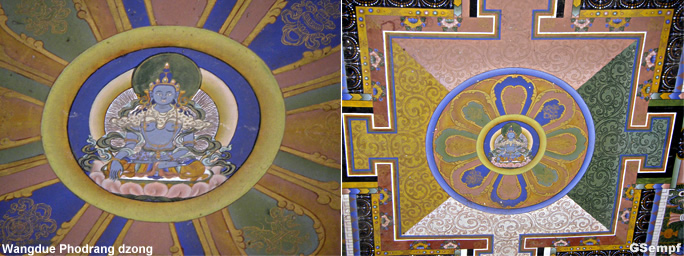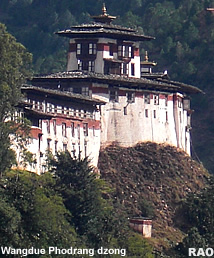| You are here: | Home > Bhutan > Overview > Culture > Religion > Dzongs > Wangduephodrang Dzong > History | Search |
 |
| Bhutan's Culture |
| Wangduephodrang Dzong |
|
 |
| Wangduephodrang Dzong |
| History |
The dzongs were built to replace the loss of Gsang sngags zab dong,i (Semtokha Dzong).Semtokha dzong was destroyed in 1634 during the Bhutan-Tibet war.Until then it served as the permanent fortified seat of Zhabdrung's administration. The completion of the two monastic fortresses marked the start of a new government system called choe si (chos srid).It was in these architectural marvels that Zhabdrung was able to combine the state monastery and administrative centre within a single fortified enclosure for the first time.Zhabdrung first instituted the clergy after the completion of the dzong.Later, the 10th Je Khenpo, Tenzin Chogyal (r.1755-1762), increased its strength. "The dual function is reflected further in their official designation as Chos Dzong ("religious fortress"), though by custom the abbreviation from the rDzong is mostly used."ii |
|
Both the dzongs epitomise Bhutanese architecture.According to historian John Ardussi, the architectural precedent was Tibetan but, because of the many uniquely Bhutanese constructional practices, it gave the dzongs a character of their own.
Both the dzongs were built on imposing sites, and at confluences with beautiful cantilever bridges in front of them.
Another common thread is that both have a story of an elephant.While the former was built on the trunk of a sleeping elephant, the latter was constructed in the shape of one.
Both dzongs have massive gateways with many flag stone courtyards, which are connected with passageways.
History
Zhabdrung chose the site, because it was next to Lama Drukpa Kinley's monastery, Chimi lhakang. "The location was selected owing to its proximity to the ancient Khyi 'bur-lha khang of 'Brug pa-kun legs, its auspicious triangular shape, and because the river produced a sound "like thousand dragons uttering the mantra hum."iii
The size of the original dzong is unknown, but history books in Bhutan state that the fourth Desi, Tenzin Rabgay (1680-1694), extended it and also added another two-storied tower. "The construction was overseen by Dzongpon Geduen Chophel.iv The Dzong has 14 temples including kunrey."v
But history written by western scholars is silent about this extension. "The original size of Wangduephodrang is not stated in our sources, but was probably substantially the same as at the present day."vi
Although all known written sources are silent about details of the construction of these two dzongs, sources unanimously state that the possession of Punakha and Wangduephodrang fortresses was decisive in the Zhabdrung's bid for supremacy in Bhutan.
"One 18th century text even claims that this supremacy was already complete in the year of Wangduephodrang's construction.But that was not quite the case, for a third and final war with Gtsang (Central Tibet) was fought in 1639."vii
Wangzops
The Wangduephodrang dzong is and has always been the provincial capital of the Shar district.In the feudal days, a Dzongpon was the secular administrator, and the local ruler of Wangdue was known as the Wangzop.
During the days of the first king and before that, the post carried a seat in the council.People close to power served as the Wangzop.
Even the first king Ugyen Wangchuck (r.1907-1926) served as its provincial administrator before he became the Trongsa Penlop.
The 7th Wangzop, Sonam Lhendup, is said to have added new structures and installed a Buddha statue. "With the passage of time, a powerful local lord, known as Kawang Sangye, extended the dzong towards the present town. Another Wangzop, Acho Boep, ordered further construction, modifying the dzong into the form in which it appears today."viii
The 16th Desi, Sonam Lhendup, also served as the Wangzop (c.1751-1761) and, during his tenure, served as a Bhutanese emissary to Ladakh.He was still in that position in 1761.
Because the Wangzop was one of the three most influential people in the country, the British kept a close watch on him. The British annual reports always mentioned him.Although it is not sure when the post of Wangzop was done away with but, from the British annual reports, it is clear that the post was vacant from 1929-43.
In the days before monarchy, two things determined the status and the power of a post.The first was the degree of access to the annual subsidy,ix which Bhutan received from the British, the second was strength of its army.
The subsidy was Rs 50,000 and it was distributed to 20x recipients, including individuals and institutions.The Wangduephodrang Dzongpon, the Wangzop, received Rs 2,931, which made him the sixth highest recipient. The Wangzop had the fourth largest army in numbers.Before 1907, the Trongsa Penlop told the British that the strength of the Bhutanese army was 9,950.xi Of it, the Wangzop had 400 soldiers.
Fire
The Wangduephodrang dzong was destroyed several times, but it was always re-built. "In 1837, it was destroyed by fire but rebuilt. During the time of Lama Neten Palden Singye, the dzong was damaged by a severe earthquake and rebuilt. Dzonpon Domchung xii was also involved in the renovation, although the date is not known. During the reign of the second king xiii and third king,xiv major renovation was done on the dzong.Senior monks, who lived in the dzong, said that, until a few years ago, one could find treasures from the old dzong on the slopes of Dangchu river.
A recently retrieved document indicates that the Wangduephodrang dzong also had a kharsapani. In addition to several of Zhabdrung's personal effects, after the fire, the personal prayer book of Zhabrung was found in the dzong.
In keeping with the wisdom of Zhabdrung, all the dzongs in the country still serve as the religious centre and house the civil administration.History will remember Wangduephodrang dzong as a architectural masterpiece.
|
|
End notes
i According to historian John Ardussi, "Gsang sngags zab don ("Sangnga zabdon") was the religious name of Semtokha Dzong, after it was built. Semtokha originally belonged to the Lhapa Lama enemy of the Zhabdrung. It was burnt down in a fire during their struggles, so the Drukpa monastery on this site actually predates the Zhabdrung.
ii P.221., Ardussi, John A. History of Bhutan before 1763.
iii Ardussi, John A. History of Bhutan before 1763.
iv p.85, Dzongs of Bhutan, Bhutan Times Limited
v p.97 Dzongs of Bhutan, Bhutan Times Limited
vi Ardussi, John A, History of Bhutan before 1763.
vii P.222, Ardussi, John. A. History of Bhutan before 1763.
viii p.85, Dzongs of Bhutan, Bhutan Times Limited
ix The Indian government gave Bhutan Rs. 50,000 as a subsidy for the cessation of the Duars. This was Bhutan's only certain source of revenue and it formed the basis of the financial system of the country.
x British Library
xi It is impossible to state that in peace time any kind of regular organization exists- probably not; but undoubtedly during war some attempt would be made to organize the numerous retainers into regular formed bodies, under the most capable of the immediate personal attendants and orderlies of the various Jongpens and Penlops. (From British Records maintained in the British Library)
xii "The powerful governor of Wangduphodrang, Kuenzang Domchu, who ruled the Wangduephodrang region in the late 19th century, commissioned an image of himself towards the fag end of his life to make amendments for the sins he had committed in his life time. He cast the huge cup for offering butter lamp and placed it on his head as a symbol of appeasement to Lama Drukpa Kuenley in whom he sought refuge during his later years." p.24, Chime Lhakhang: The Abode of Fertility, Department of Tourism,
xiii Major renovation was carried out in Tongsa Dzong in 1930 and in Wangdiphodrang Dzong in 1948." p.57, Ura, Karma Dasho, Leadership of the Wise, Kings of Bhutan.
xiv Under the supervision of Dronyer Pema Wangdi.
| This article was contributed by Tshering Tashi, KUENSEL, Bhutan's National Newspaper 2012 |

|

|
| Information on Bhutan |
|
||||||||||||||||||||||||
|

|
